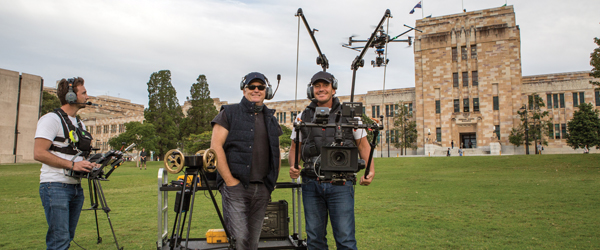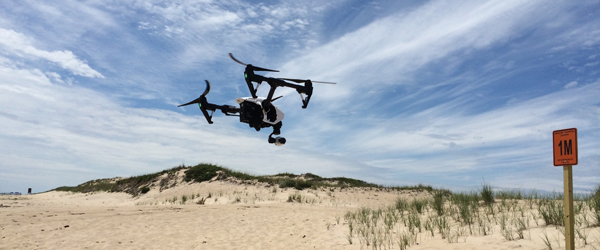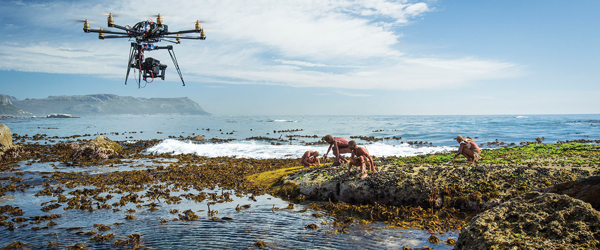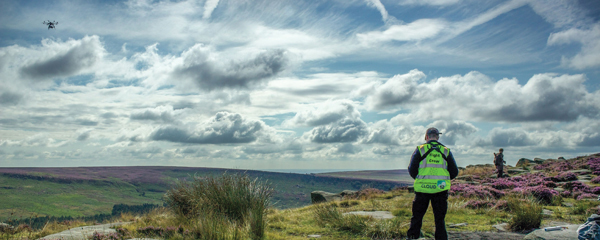Drone filming & the freedom of unmanned flight
Aerial drones – or Unmanned Aerial Vehicles (UAV), to use the industry terminology – have become an increasingly prevalent part of the international production landscape. Usually small, mobile and flexible, the devices appear to offer a safer alternative to the traditional method of filming aerial footage. But how is the technology evolving and will it eventually make helicopter and aeroplane filming obsolete?
Professional UAV operators almost invariably use star-design drones for commercial filming purposes. This involves up to a dozen separate horizontally-mounted rotor blades arranged in a star-like formation, which physically manoeuvre the UAV through the air. The camera – referred to as the payload – is suspended beneath this flight deck in a gyroscope.
Clearly this proximity would not be possible with a helicopter, while the set-up and safety considerations would also be more time-consuming.
A UAV flight usually takes two operators – one to control the rotors and fly the device and another to separately control the camera functions. Randy Scott Slavin is an aerial photography specialist based in New York, who also founded the New York City Drone Film Festival in 2014.
“Drones are exciting because they offer the ability to completely free up the motion of the camera and put it anywhere that you want in 3D space,” Slavin says.
The advantages posed by UAVs in the production industry are considerable. A drone can film from any angle and is immediately cheaper and safer than using a helicopter. Expensive fuel costs are not a factor and nobody is being sent into the sky at inevitable risk of injury.
 Marco van Belle is a filmmaker with lots of experience of aerial shooting, who decided a drone was the best option for his independent feature Arthur & Merlin. Cost, versatility and the rapid set-up time were major attractions.
Marco van Belle is a filmmaker with lots of experience of aerial shooting, who decided a drone was the best option for his independent feature Arthur & Merlin. Cost, versatility and the rapid set-up time were major attractions.
Legislative restrictions are among the major issues affecting UAV usage, especially in the US.
“With a drone, we were able to get the kind of big, expansive wide shots you'd expect from aerial photography,” Van Belle comments, “but we were also able to film very close to the actors and put the camera right in the middle of the action.
“When you film close to actors like we did, it's much easier in terms of health and safety if you're using a drone. I managed to get shots from the drone where the camera was zipping past my actors at head-height.”
Clearly this proximity would not be possible with a helicopter, while the set-up and safety considerations would also be more time-consuming.
“That's not to say there aren't health and safety considerations with drones though,” Van Belle adds: “You still have to operate in a very cautious fashion and take safety issues very seriously.”
For all the creative possibilities, the technology is still young and there are notable limitations to how UAVs can operate when out on location.
Ben Keene is an aerial filming specialist with UK-based operator Cloud 12 and works with a UAV called an Octocopter. Keene and his team recently worked on high-profile features including the action sequel London Has Fallen, Vampire Academy and Woman in Black 2, as well as numerous commercial campaigns for the likes of Nike and Three Mobile.
“Weather is a massive driver and we look at the forecast 24 hours ahead of the shoot,” Keene explains: “Any kind of rain makes it a no-go because the Octocopter is electrical and open to air flow. The rig has a higher tolerance to wind – up to 30 mph – but higher winds could degrade image quality. The actual Octocopter is gimbal-stabilised, but the camera itself will still be moving in the wind.”
 Cloud 12 recommends a technical scout of the intended filming location ahead of the shoot. The company issues clients a “No-Go” and a refund if adverse weather is forecast 24 hours before the scheduled filming.
Cloud 12 recommends a technical scout of the intended filming location ahead of the shoot. The company issues clients a “No-Go” and a refund if adverse weather is forecast 24 hours before the scheduled filming.
“We almost didn't manage to get an important shot because the drone was being badly affected by the conditions,” says Van Belle: “Every aerial shot in the film had to be stabilised digitally in post despite the fact that our drone had a top-of-the-line gimbal system, but stabilisation software is very good now and the shots didn't suffer at all.”
Having UAVs positioned as toys available to any consumer – regardless of their level of expertise – is an international issue that also threatens to undermine confidence in professional operators.
Flight times are also extremely limited – usually to just a few minutes – but operators travel with multiple battery packs and maintain efficient charging patterns to minimise delays. While this seems like a major disadvantage, Slavin suggests that it can be turned to a production’s advantage.
“Having a production set up where the drone is only in the air for a few minutes at a time is actually good for safety,” Slavin offers: “It means you’re constantly checking systems to make sure everything is working as it should be.”
Legislative restrictions are among the major issues affecting UAV usage, especially in the US. Until very recently, America’s Federal Aviation Administration (FAA) had a blanket ban on any commercial usage of UAVs in American airspace, which Keene suggests was part of the legacy of the 9/11 terrorist attacks. In late 2014 for the first time the FAA allowed a small number of US production companies to start using drones for commercial purposes, and in mid-2015 plans were announced to work with organisations including CNN to investigate and test drones for newsgathering and industrial roles.
 Perhaps surprisingly, Slavin does not in fact believe UAVs are over-regulated in the US, but rather posits that strict legislation is necessary, given how easy drones are to acquire.
Perhaps surprisingly, Slavin does not in fact believe UAVs are over-regulated in the US, but rather posits that strict legislation is necessary, given how easy drones are to acquire.
“The Federal Aviation Administration is doing the best it can to share US airspace safely,” Slavin argues: “The reality is that hobbyists need to be regulated. Drones require a responsible pilot.”
Having UAVs positioned as toys available to any consumer – regardless of their level of expertise – is an international issue that also threatens to undermine confidence in professional operators. A quick online search reveals a host of camera-equipped drones available to buy – some for less than GBP30 – which is a strong indicator of the scale of the issue.
“As an operator,” Keene considers, “I would say that greater regulations could needlessly complicate the process, but at the same time amateur usage is potentially a problem. Drones can feel like toys and can be bought in high-street electronics stores, so education at the point of sale would really help.”
The standard of practice and indeed of the footage being captured by drones is central to the future of aerial filming.
In the UK, drone flights are regulated by the Civil Aviation Authority (CAA) in a flexible manner that Keene considers “trailblazing” in terms of the impact the approach has had internationally. The CAA in fact recently worked with drone supplier First Person View to create a short animated film explaining the common-sense UK regulations. Operators are warned to avoid buildings and congested areas, and also to consider privacy considerations when they film from the air.
Guy Alexander, of Australian drone operator Heliguy, believes that training courses need to be more stringent for the sake of the industry.
“You can sit a course for a few days now and get someone to do your operations manual and you’ll be certified very quickly,” he comments.
“It’s to the point now that hourly and per-flight rates are being offered. It’s not sustainable. I’m hoping that the FAA and other countries don’t take the same approach as the standards of practice will go down considerably. I have seen this happen to our industry.”
The standard of practice and indeed of the footage being captured by drones is central to the future of aerial filming. Slavin believes helicopter pilots should consider training as UAV operators to ensure they can offer both services with a high degree of expertise. Keene and Alexander take a slightly different view and stress that while drones are cheaper, safer and more flexible than putting a helicopter in the air, the two nonetheless remain separate markets.
“If you’re looking for sweeping landscape shots over a long distance, then you want a helicopter,” Keene insists: “Drones can offer greater flexibility and are able to mimic a dolly, a Steadicam and a crane in a single shot, but they’re not robust machines.”
“You cannot beat a real chopper with a stabilised head for speed and movement,” agrees Alexander: “For close-quarter reveals and using foreground within one hundred or two hundred metres maximum, the drone can certainly get some nice aerials. For me real choppers rule the big stuff.”
Van Belle points out that ease of communication is a major advantage that drones have over helicopters, given that the UAV operator is always on the ground with the director. This also has cost-saving implications.
“With a drone, you're able to stand beside the pilot and brief him in detail from one shot to the next,” he explains: “With a helicopter, you're often only able to speak to the team in the air via a radio, which can result in muddied communication and result in lost time as you re-issue instructions and repeat multiple takes.”
The future looks bright for the UAV market as the technology rapidly evolves. Major brands will likely help raise the profile of the UAV market still further. Nick Woodman, CEO of the all-conquering action-cam company GoPro is a recent example, revealing in mid-2015 that the firm was working on its first drone design.
For Keene, the UAV market can really start to flourish once it shakes itself free of the faddish element that has lurked in the background for the past couple of years.
“Three years ago everyone wanted a drone shot because they made films feel special,” he comments: “Now that they’re much more prominent, there’s a real tendency for operators to over-promise and under-deliver. The fad stage is now coming to an end and the operators left in the market are increasingly experienced and able to deliver. Technology is improving and specialist companies like Arri are now designing equipment specifically for use on the Octocopter.”
“The flight controls are improving,” Alexander agrees: “There are more manufacturers coming into the fold. With this competition everything is getting better, from stability of the camera to stability of the drone in high winds and there is a lot of information about the next phase of battery technology which will revolutionise flight times.”
Related Posts
- Aerial filming in the UK
- New code of practice for UK drone filming highlights privacy concerns
- ESPN to film with unmanned drones at Winter X Games in Colorado
- TLG talks to legendary film pilot Marc Wolff
- New ruling allows six US production companies to film with unmanned drones
- OB Management uses specialist OctoCopter filming on location in Manila slum
- Director James Cameron supports drone filming innovation in New Zealand
- The Location Guide talks to Lieutenant Colonel Glen Roberts, Director of the United States Air Force Entertainment Liaison Office
Related posts:
Comments
Not Logged in
You must be logged in to post a comment

There are no comments